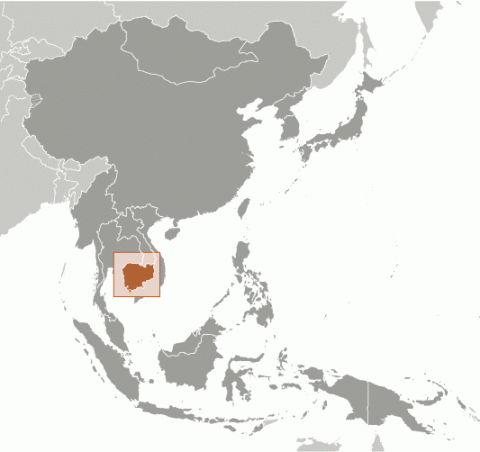Child Labor and Forced Labor Reports
Cambodia


Minimal Advancement – Efforts Made but Continued Practice that Delayed Advancement
In 2024, Cambodia made minimal advancement in efforts to eliminate the worst forms of child labor. The Ministry of Education, Youth, and Sport added 50 primary schools to its full-time school pilot program, transitioning students to full-day learning and thereby reducing their risk of child labor. The government also launched a Training Curriculum and Master Training Plan for the Social Service Workforce, the country's first standardized training program for social workers focused specifically on child protection. Furthermore, the Ministry of Labor and Vocational Training increased the number of labor inspectors from 572 to 631. However, despite these new initiatives to address child labor, Cambodia is assessed as having made only minimal advancement because the government failed to take active measures to investigate, prosecute, convict, and sentence public officials who participate in or facilitate the worst forms of child labor, including commercial sexual exploitation of children and debt-based forced labor in brick kilns. In addition, judges, police, and labor inspectors were reported to have accepted bribes to overlook child labor and forced child labor offenses in the country, especially when the perpetrator had alleged ties with the government. Lastly, the laws prohibiting commercial sexual exploitation of children are insufficient, because the procurement of children for pornography and pornographic performances requires the use of deception, abuse of power, confinement, force, threat, or coercion.
| Children | Age | Percent and Population |
|---|---|---|
| Working | 5 to 14 | 8.9% (285,499) |
| Boys | 9.3% | |
| Girls | 8.6% | |
| Urban | 5.4% | |
| Rural | 10.6% | |
| Hazardous Work by Children | 15 to 17 | 20.7% (202,618) |
| Boys | 22.8% | |
| Girls | 18.5% | |
| Urban | 18.6% | |
| Rural | 22.1% | |
| Attending School | 5 to 14 | 87.3% |
| Combining Work and School | 7 to 14 | 9.0% |
| Sector/Industry | Percent of Population |
|---|---|
| Agriculture | 72.5% |
| Industry | 5.9% |
| Services | 21.6% |
| Sector/Industry | Activity |
|---|---|
| Agriculture | Fishing, including deep-sea† and night fishing;† processing shrimp; logging† for the production of timber; herding bovines; producing tobacco, cassava, rubber, and sugarcane. |
| Industry | Making bricks,† including feeding clay into brickmaking machines, removing wood fuel from trucks and feeding to brickmaking machines, drying bricks, transporting bricks to the oven,† and loading bricks onto and off of trucks. Working in construction† and in slaughterhouses for meat production.† Producing alcoholic beverages† and textiles. |
| Services | Domestic work. Street work, including car washing, begging, vending, garbage scavenging, and collecting garbage. Also working as security guards† and in entertainment† as bartenders,† masseurs,† dancers,† and waiters.† |
| Categorical Worst Forms of Child Labor‡ | Commercial sexual exploitation, sometimes as a result of human trafficking. Forced begging and street begging. Forced labor in the production of bricks. |
† Determined by national law or regulation as hazardous and, as such, relevant to Article 3(d) of ILO C. 182.
‡ Child labor understood as the worst forms of child labor per se under Article 3(a)–(c) of ILO C. 182.
Children at Higher Risk
For years, debt bondage has pervaded the brick industry in Cambodia. Brick kiln owners offer loans to Cambodians in need, in exchange for their work in brick production, only to inflate the debts, charge extremely high interest rates, and impose unachievable targets for brick production. As a result, the workers are unable to ever pay back their loans, trapping them in debt bondage. Many families bring their children to the kilns to help them produce more bricks, resulting in intergenerational debt bondage and forced child labor. Additionally, the microfinance industry in Cambodia has grown rapidly with inadequate regulation, leading to an increasing number of overburdened debtors. Cambodian human rights organizations cite cases of extrajudicial land sales, child labor, and debt bondage linked to the microfinance crisis. Research also showed that children were taken out of school so they could work to help with debt repayment. Finally, the number of women and girls traveling from Cambodia to China for forced or arranged marriages continues to grow.
Barriers to Education Access
The Education Law establishes free basic education for citizens only, and unofficial school-related fees, such as for extra classes or school uniforms, are prohibitive for some families. Other barriers to education include denied enrollment for children without birth certificates, limited transportation to schools in remote areas, a lack of drinking water, a severe shortage of teachers, language barriers, and a lack of safe sanitation conditions in some schools. Sanitation conditions are particularly unsafe in Cambodia's "floating schools" on or near fishing communities, to which children as young as age 6 row themselves by boat each day. These barriers disproportionately affect non-Khmer children, children with disabilities, and children from rural and disadvantaged communities.
| Standard | Age | Meets International Standards | Legislation |
|---|---|---|---|
| Minimum Age for Work | 15 | ✗ | Articles 1, 3, and 177 of the Labor Law |
| Minimum Age for Hazardous Work | 18 | ✓ | Articles 173 and 177 of the Labor Law; Regulation on the Prohibition of Hazardous Child Labor; Articles 339 and 340 of the Penal Code |
| Identification of Hazardous Occupations or Activities Prohibited for Children | ✓ | Article 2 of the Regulation on the Prohibition of Hazardous Child Labor | |
| Prohibition of Slavery, Debt Bondage, and Forced Labor | ✓ | Articles 15, 16, 369, and 370 of the Labor Law; Articles 7, 10, 12, 13, 15–17, and 19 of the Law on Suppression of Human Trafficking and Sexual Exploitation | |
| Prohibition of Child Trafficking | ✗ | Articles 7, 8, 10, 12, 13, 15, 17, and 19 of the Law on Suppression of Human Trafficking and Sexual Exploitation | |
| Prohibition of Commercial Sexual Exploitation of Children | ✗ | Articles 7, 10, 12, 13, 15, 19, 23, 25, 28, 30–37, 40, and 41 of the Law on Suppression of Human Trafficking and Sexual Exploitation; Articles 284, 289, 342, and 346 of the Penal Code | |
| Prohibition of Using Children in Illicit Activities | ✓ | Article 345 of the Penal Code; Articles 3 and 47 of the Law on Control of Drugs | |
| Minimum Age for Voluntary State Military Recruitment | 18 | ✓ | Articles 41 and 42 of the Law on General Statutes for the Military Personnel of the Royal Cambodian Armed Forces |
| Prohibition of Compulsory Recruitment of Children by (State) Military | ✓ | Article 2 of the Law on Compulsory Military Service | |
| Prohibition of Military Recruitment by Non‑state Armed Groups | ✗ | ||
| Compulsory Education Age | ✗ | ||
| Free Public Education | ✗ | Article 31 of the Education Law; Article 68 of the Constitution |
Cambodian laws do not sufficiently prohibit the commercial sexual exploitation of children, as the criminal prohibition on procuring children for pornography and pornographic performances requires the use of deception, abuse of power, confinement, force, threat, or coercion. Similarly, Cambodian laws do not sufficiently prohibit child trafficking because the recruitment, transportation, harboring, and receipt of a child for the purpose of exploitation requires the use of force, fraud, or coercion to constitute a child trafficking crime. Although the Labor Code prohibits work by children under age 15, the law does not apply to children outside of formal employment relationships and, therefore, does not conform to international standards that require all children be protected under the law that sets a minimum age for work. Moreover, the Ministry of Labor and Vocational Training's (MOLVT) regulation on household work extends minimum age protections for domestic workers to age 18 and provides clear definitions of household work, but it does not specify legal protections for domestic workers employed in informal relationships, including when working for their relatives without a contract. Furthermore, free basic public education is only available to citizens, and Cambodia lacks compulsory schooling, which leaves children under age 15 particularly vulnerable to child labor because they are not required to be in school but are not yet legally permitted to work.
| Organization/Agency | Role & Activities |
|---|
| Ministry of Labor and Vocational Training (MOLVT): Enforces child-related provisions of the Labor Law and trains Commune Committees for Women and Children that oversee local child labor monitoring systems. Tasked with removing children from child labor, including at brick kilns. Head of MOLVT's Child Labor Bureau also serves as the Secretary General of the National Committee on Countering Child Labor. Refers cases involving possible criminal violations to the Anti-Human Trafficking and Juvenile Protection Department (AHTJP). Some labor inspectors in MOLVT have been trained and granted "judicial police" status, which allows them to investigate and submit criminal complaints directly to the court, though there is no evidence that trained MOLVT inspectors have exercised these powers yet. During the reporting period, MOLVT, in collaboration with the Ministry of Posts and Telecommunications, launched an instant messaging campaign to spread awareness of the dangers of child labor and its worst forms. MOLVT also implemented its annual child labor intervention projects, which assisted 400 children in accessing education, school supplies, clothing, and transportation. MOLVT launched an anonymous complaint box in which the public can report labor violations, including child labor violations. Research indicates that Cambodia's labor inspectorate lacks sufficient resources to carry out inspections. In addition, reports suggest a lack of unannounced inspections in the informal, construction, and entertainment sectors. |
| Ministry of the Interior Cambodian National Police AHTJP: Enforces laws against human trafficking and commercial sexual exploitation of children in collaboration with municipal and provincial anti-human trafficking and juvenile protection offices. Fields complaints from the public about human trafficking, which can be filed through the anti-human trafficking hotline. Oversees the Information and Technology Office, which searches for evidence of human trafficking and sexual exploitation of children on the internet, in printed media, and in other sources. During the reporting period, AHTJP investigated crimes related to the worst forms of child labor, though information about these investigations is limited. However, despite the prevalence of bonded child labor in Cambodian brick kilns, AHTJP continued to view brick kiln inspections as under the purview of MOLVT, limiting criminal investigations in the sector. Additionally, reports indicate that discrepancies in criminal law enforcement data are common. |
| Overview of Enforcement Efforts | 2024 |
|---|---|
| Has a Labor Inspectorate | Yes |
| Able to Assess Civil Penalties | Yes |
| Routinely Conducted Worksite Inspections | Yes |
| Unannounced Inspections Permitted | Yes |
| Has a Complaint Mechanism | Yes |
| Imposed Penalties for Child Labor Violations | Yes |
| Conducted Criminal Investigations for Worst Forms of Child Labor Crimes | Yes |
| Imposed Penalties for Worst Forms of Child Labor Crimes | Yes |
In 2024, 631 labor inspectors conducted 547 worksite inspections, finding 9 child labor violations. The number of criminal investigations into suspected worst forms of child labor crimes conducted, prosecutions initiated, and perpetrators convicted is unknown.
Evidence suggests that labor inspectors and other law enforcement personnel are unwilling to investigate child labor allegations involving powerful business owners. In addition, law enforcement officials have requested bribes from employers when child labor violations have been found. Malfeasance within MOLVT and law enforcement agencies limits the capacity of local authorities to adequately enforce regulations for children related to hazardous work, resulting in penalties related to the worst forms of child labor rarely being imposed in accordance with the law. Additionally, the Government of Cambodia has failed to regularly investigate, prosecute, or convict public officials who participate in or facilitate the worst forms of child labor, including commercial sexual exploitation of children and debt-based forced labor in brick kilns. NGO contacts claim that the government has limited political will to investigate any Cambodian officials complicit in these illegal activities, and there was no evidence of public officials being investigated, prosecuted, or convicted during the reporting period.
| Coordinating Body | Role & Activities |
|---|
| National Committee for Countering Child Labor: Serves as the primary interagency coordinating body for the government's various ministries on child labor issues. The Minister of Labor serves as its chair and the head of MOLVT's Child Labor Bureau serves as the Secretary General. Coordination on child labor across relevant ministries remains a challenge, with most coordination occurring on an ad hoc basis rather than through formalized and regular channels. During the reporting period, the National Committee for Countering Child Labor met regularly to discuss how it can enhance efficiency in collecting information and data about child labor in Cambodia, though no specific deliverables were reported. |
| Policy | Description & Activities |
|---|
| National Plan of Action on Child Labor Reduction and Elimination of the Worst Forms of Child Labor (2016–2025): Overseen by MOLVT and aims to build the capacity of law enforcement officers, raise public awareness of child labor issues, enhance child labor monitoring systems at the community level, and create a roadmap to eradicate the worst forms of child labor by 2025 in various sectors, including services, agriculture, mining, and energy. During the reporting period, MOLVT provided capacity building support for national and provincial officials on child labor inspections and awareness. In addition, the Ministry inspected sectors prone to child labor, including sugarcane, rubber, and cassava plantations, as well as brick kilns. MOLVT also conducted an assessment of the National Action Plan to inform the drafting of the new plan for 2026–2035. |
| Five-Year National Strategic Plan for Countering Trafficking in Persons (2024–2028):* Facilitated by the National Committee for Counter Trafficking and aims to provide a roadmap for various agencies, ministries, and institutions at both national and sub-national levels to develop policies, programs, and coordination mechanisms that address and prevent human trafficking, including child trafficking. The new Strategic Plan was launched during the reporting period. |
| Child Labor Elimination Policy and Strategic Framework for the Fisheries Sector (2024-2030): Aims to prevent and withdraw children from child labor and hazardous work in the fisheries sector, and to improve monitoring and evaluation mechanisms on child labor in this sector. In 2024, officials reported that the Ministry of Agriculture, Forestry, and Fisheries trained officials and held workshops to raise awareness of child labor in fisheries, though the number of officials trained and workshops held is unknown. During the reporting period, stakeholders launched the Policy and Strategic Framework for the Fisheries Sector (2024–2030), which outlines specific policy plans and priorities for the implementation of the Plan. |
* Policy was approved during the reporting period.
† The government had other policies that may have addressed child labor issues or had an impact on child labor.
| Program | Description & Activities |
|---|
| The Family Package:‡* Established in 2024 by the Government of Cambodia and UNICEF. Integrates all existing social assistance benefits in the country—including the Cash Transfer for Pregnant Women and Children Under Two, the Cash Transfer for Children from Poor Households in Primary and Secondary Schools, and the Cash Transfer for Persons with Disabilities—and offers an accessible digital delivery system for users. Aims to support vulnerable and impoverished families and children. In 2024, the program reached 750,000 children. |
| UN WFP Country Program (2020–2024):‡ Multi-government and private sector-funded program implemented in collaboration with the Government of Cambodia that includes a school feeding program for children in need. The Government of Cambodia currently funds 553 of the 1,114 schools participating in the program. During the reporting period, the program provided school meals to 150,000 children in Seam Reap, Oddar Meanchey, Kampong Thom, Kampong Chhnang, and Pursat provinces. |
| Family Care First (FCF/REACT): Led by Ministry of Social Affairs, Veterans and Youth Rehabilitation. Aims to reduce child labor and exploitation by keeping families united and giving children safe, nurturing environments. Activities include supporting the development of Social Service Workforce Training curriculum, the reintegration of children from residential care institutions to family‐based care, the closure of residential care institutions, and the provision of social services. During the reporting period, FCF helped reintegrate 417 children with their parents, provided cash transfers to 615 impoverished households, and trained more than 1,171 child protection service providers. |
* Program was launched during the reporting period.
‡ Program is funded by the Government of Cambodia.
† The government had other social programs that may have included the goal of eliminating or preventing child labor.
| Area | Suggested Action |
|---|---|
| Legal Framework | Ensure that the minimum age for work applies to all children, including those without a formal employment agreement. |
| Criminalize the procuring of children for pornography and pornographic performances, regardless of whether deception, abuse of power, or any other means were involved in such recruitment. | |
| Criminalize the recruitment, transportation, harboring, and receipt of a child for the purpose of exploitation without requiring the use of force, fraud, or coercion. | |
| Establish a law that criminally prohibits the recruitment of children by non-state armed groups. | |
| Establish a compulsory education age of 15, the minimum age for employment, and ensure that laws establish free public education for all children. | |
| Enforcement | Provide the labor inspectorate with sufficient funding, resources, and technical training opportunities to conduct thorough and sufficient labor inspections in all geographies and workplaces. |
| Conduct unannounced inspections in all sectors in which child labor is reported to occur, including in the informal, construction, and entertainment sectors. | |
| Collect, properly store, and publicly release disaggregated data on criminal law enforcement efforts related to the worst forms of child labor, including the number of prosecutions initiated, the number of convictions, and the number of investigations conducted. | |
| Address malfeasance in all law enforcement agencies, including by prohibiting the acceptance of bribes to influence the outcome of cases or providing tip-offs in advance of raids, and investigating and prosecuting individuals and government officials who are complicit in facilitating and profiting from the worst forms of child labor. | |
| Train all criminal law enforcement officials on human trafficking indicators and how to conduct investigations into trafficking crimes, and ensure that funding is sufficient to cover expenses, including transportation costs. | |
| Develop standard judicial procedures to monitor human trafficking perpetrators pending trial to prevent criminals from fleeing and to enable victims to receive restitution. | |
| Coordination | Improve interministerial coordination to address child labor, including but not limited to reporting efforts made by the National Committee on Countering Child Labor to implement the National Plan of Action on Combating the Worst Forms of Child Labor. |
| Publish activities undertaken by the National Committee on Countering Child Labor on an annual basis. | |
| Resolve conflicting and overlapping mandates between enforcement bodies that may hinder enforcement of child labor laws, including by providing inspectors of construction sites training on identifying child labor violations and ensuring that such training is coordinated with the Ministry of Labor and Vocational Training's labor inspectorate to ensure inspectors' safety, and by delineating the roles and responsibilities of enforcement agencies in child labor and worst forms of child labor violations and crimes. | |
| Government Policies | Renew the expired Action Plan to Prevent and Respond to Violence Against Children to address and prevent the online sexual exploitation of children in Cambodia. |
| Increase regulation of microfinance and lending institutions to reduce borrowers' vulnerability to debt-based coercion and provide support to children whose families are victims of predatory microfinance institutions. | |
| Social Programs | Publish the results of the 2019 nationwide child labor survey to inform policies, enforcement, and social programs. |
| Increase access to free basic education by eliminating unofficial school-related fees; addressing issues related to limited transportation and inadequate school infrastructure, including unsafe "floating schools" on or near fishing communities; eliminating barriers to school for non-Khmer children, children with disabilities, girls, and children from rural and disadvantaged communities; and providing safe, sanitary schools with access to water and latrines. | |
| Provide sufficient funding for social programs so that they can fully address the extent of child labor in Cambodia, particularly the online sexual exploitation of children. |















